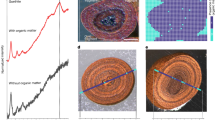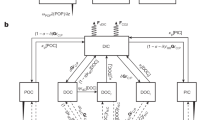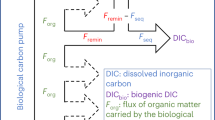Abstract
RECENT measurements1 of the amount of dissolved organic carbon (DOC) in sea water using a high-temperature catalytic oxidation (HTCO) method have generated intense interest because they indicated concentrations several times greater than those obtained from conventional wet chemical oxidation (WCO) methods2–4. As dissolved organic matter in the oceans represents one of the major pools of organic matter in the biosphere5,6, these findings of 'new' DOC have prompted important revisions to models of the oceanic carbon cycle7–9. A satisfactory explanation for the origin of the 'new' DOC, however, which seems to be chemically refractory1, biologically labile10 and of high molecular mass1, has not been forthcoming. Here we present a comparison of measurements of seawater DOC using the HTCO and WCO methods. We obtain fairly good agreement between the two methods, with the HTCO results being considerably lower than those reported previously1. Our data suggest that the WCO technique may not fail to detect so much DOC as had been previously supposed, and that any carbon that is missed by this method may be in the low- rather than the high-molecular-mass fraction.
This is a preview of subscription content, access via your institution
Access options
Subscribe to this journal
Receive 51 print issues and online access
$199.00 per year
only $3.90 per issue
Buy this article
- Purchase on SpringerLink
- Instant access to full article PDF
Prices may be subject to local taxes which are calculated during checkout
Similar content being viewed by others
References
Sugimura, Y. & Suzuki, Y. Mar. Chem. 24, 105–131 (1988).
Menzel, D. W. & Vaccaro, R. F. Limnol. Oceanogr. 9, 138–142 (1964).
Strickland, J. D. H. & Parsons, T. R. in A Practical Handbook of Seawater Analysis, Fish. Res. Board Can. Bull. 167, 310 (1972).
Sharp, J. H. Mar. Chem. 1, 211–229 (1973).
Williams, P. M. in Organic Compounds in Aquatic Environments (eds Faust, S. J. & Hunter, J. V.) 145–164 (Marcel Dekker, New York, 1971).
Mopper, K. & Degens, E. T. in The Global Carbon Cycle (eds Bolin, B. et al.) 293–316 (Wiley, New York. 1979).
Legendre, L. & Gosselin, M. Limnol. Oceanogr. 34, 1374–1380 (1989).
Toggweiler, J. R. Nature 347, 122–123 (1990).
Bascastow, R. & Maier-Reimer, E. Glob. biogeochem. Cycles 5, 71–85 (1991).
Kirchman, D. L., Suzuki, Y., Garside, C. & Ducklow, H. W. Nature 352, 612–614 (1991).
Ogura, N. Mar. Biol. 24, 305–312 (1974).
Carlson, D. J., Brann, M. L., Mague, T. H. & Mayer, L. M. Mar. Chem. 16, 155–171 (1985).
Gershey, R. M., Mackinnon, M. D., Williams, P. J. leB. & Moore, R. M. Mar. Chem. 7, 289–306 (1979).
Mackinnon, M. D. in Marine Organic Chemistry (eds Duursma, E. K. & Dawson, R.) 415–443 (Elsevier, Amsterdam, 1981).
Barber, R. T. Nature 220, 274–275 (1968).
Ogura, N. Mar. Chem. 5, 535–549 (1977).
Williams, P. M. & Druffel, E. M. Nature 330, 246–248 (1987).
Kieber, D. J., McDaniel, J. & Mopper, K. Nature 341, 637–639 (1989).
Kieber, R. J., Zhou, X. & Mopper, K. Limnol. Oceanogr. 35, 1503–1515 (1990).
Mopper, K. et al. Nature 353, 60–62 (1991).
Author information
Authors and Affiliations
Rights and permissions
About this article
Cite this article
Ogawa, H., Ogura, N. Comparison of two methods for measuring dissolved organic carbon in sea water. Nature 356, 696–698 (1992). https://doi.org/10.1038/356696a0
Received:
Accepted:
Issue date:
DOI: https://doi.org/10.1038/356696a0
This article is cited by
-
On the integrity of a commercial cassette ultrafiltration membrane: implications for marine colloidal biogeochemistry
Acta Oceanologica Sinica (2014)
-
Comparison of HTC method and UV/persulphate method to determine colloidal organic carbon in seawater
Chinese Journal of Oceanology and Limnology (2000)



